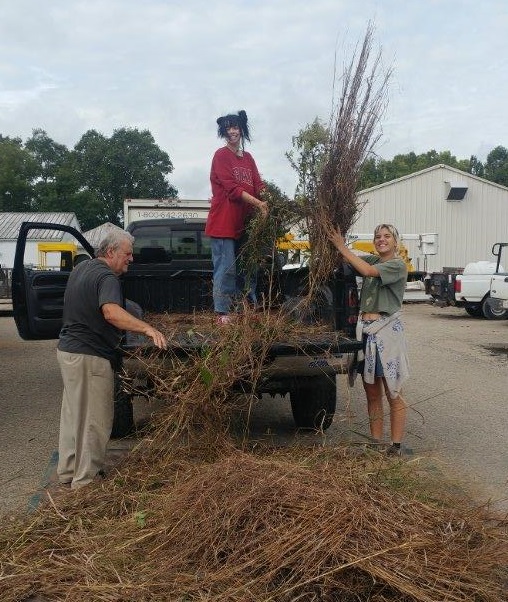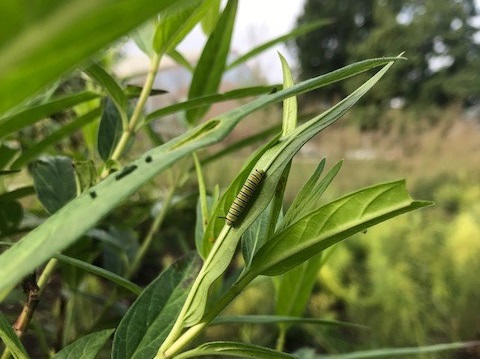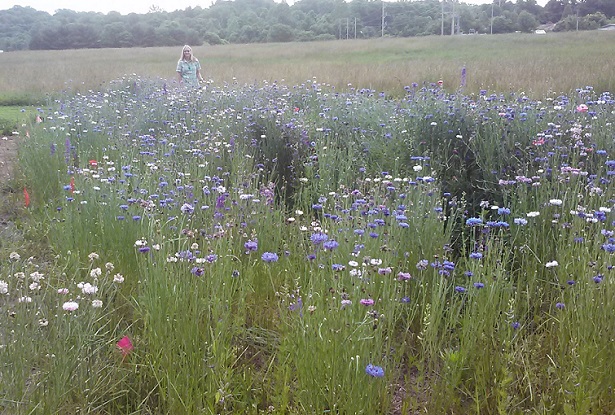Grounds Services helps preserve habitat for monarchs and other pollinators
Just as the Ohio University community prepares for winter by turning back clocks, replacing light summer clothes with warmer layers, and making plans for calamity days, so too do other species prepare for the cold of winter. Monarch butterflies, which have attracted great attention and concern in recent years because of their dwindling numbers and habitat, prepare by migrating to Mexico or southern California where they overwinter in a semi-dormant state before mating and laying eggs.
Populations of monarch butterflies, which have long been a common sight in backyards, fields, and meadows across the country, have dwindled by nearly 70 percent over the past 20 years, according to the Center for Biological Diversity. Threats to the monarch populations and their habitat include the agricultural use of herbicides, which reduces the availability of milkweed, the sole source of food for monarch larvae, or caterpillars. Climate change represents a serious threat to monarch migration and their overwintering habitat.
As monarch populations have declined, conservationists, educators, and citizen scientists have sought ways to help the monarch, and other pollinators, by preserving and protecting their food sources and habitat. In many communities across the country, there has been a push to help the monarchs by planting milkweed and the native plants that support the butterflies throughout their lifecycle.
Last year Ohio University Landscape Coordinator Susan Calhoun and her crew of student workers planted swamp milkweed in and around the South Overlook, a naturalized area between Baker University Center and Emeriti Park. Swamp milkweed is one of 13 milkweed species native to Ohio. Calhoun said she and her students have been delighted to see how well the milkweed has taken root and thrived. Swamp milkweed is one of the most common milkweed species and is found all over Ohio. Depending on growing conditions, plants can grow up to 5 feet tall. The plant thrives in wet areas like ditches, swamps, marshes, and along waterways.
“We got interested in the monarch habitat and wondered if the monarchs would find these plants,” said Calhoun. “I was thrilled this crop of students was so excited about the monarch larvae and butterflies.”
The monarchs did find the milkweed planted for them and inspired several students to monitor them as they appeared on and around the milkweed and other native plants throughout the summer and fall. “We started seeing a lot of response to our plantings,” said Calhoun. “Every time we found a larva (caterpillar) we would text each other.”
Siobhan Miller is a senior publication design major who began working with Calhoun’s landscape crew last spring and helped plant milkweed then monitored the monarchs who came to use the milkweed. Throughout the summer and fall, Miller kept a log of monarch larvae and butterfly sightings on campus and compiled a list of 38 spotted in plantings. Miller logged the monarch sightings on a website called Journey North, where citizen scientists can collaboratively track migrations.
Miller said she became interested in supporting monarch habitats and monitoring their populations after working for Calhoun this spring and summer. “Through working in the dirt every day, I noticed more monarch larvae than I ever had before,” Miller explained. “Susan started telling me about the monarchs’ depleting populations and my excitement grew every time I saw one.”
Seth Foerstner is a senior creative writing major from Cleveland who also worked with Calhoun’s landscaping crew this spring and summer. Foerstner said seeing monarchs was always a part of his childhood, but now that monarch populations have been declining, he hopes to help educate about this issue. “I didn’t really think about the cause until now,” he said. As a staff writer for SpeakEasy magazine, he hopes to spread awareness of the monarch’s plight by spreading awareness among young people and teaching them about the insects and their habitat.
Calhoun and the grounds team have also created five native plantings across campus, including two natural prairie plantings on the Ohio University Golf Course in which a family of foxes made its home for several seasons. Other native plantings are located at the Ecohouse on Dairy Lane, east of Baker University Center, Bingham House, and Carper Park near Morton Hall.
“Native plantings can thrive with little maintenance,” Calhoun said. “Prairie and wildflower plantings only need to be mowed in early spring once they are established. These plantings benefit the ecosystem by providing cover and food for wildlife as well as nectar for bees and other pollinators. We have now planted milkweed at several sites.”
The Ecohouse was designated as a Monarch Waystation and a National Wildlife Federation Certified Wildlife Habitat in 2015. This means the Ecohouse landscape provides a variety of host plants, food sources, and appropriate environmental conditions to support native pollinators and wildlife. This is the first designated site on campus.
In addition to these native planting areas, Grounds Services has developed 11 naturalized areas where they have been able to take acreage out of the mowing rotation and encourage the growth of plants that support monarchs and other pollinators such as other species of butterflies and bees. These naturalized areas are often established on slopes and other places that are difficult to mow. Many of these areas are also home to various milkweed species. Examples of these naturalized areas can be seen between Seigfried and Glidden Halls, behind Bentley Hall, and near the driving range.
When the monarchs, and other pollinators, return next spring, they will find even more options for food and habitat at Ohio University. Calhoun and her colleagues hope to add more species of native milkweed in naturalized areas and pollinator gardens around campus. Grounds crews will also continue to monitor and remove invasive species from naturalized areas and across campus. According to Calhoun, Grounds Services will continue to identify steep slopes and other areas to convert into naturalized plantings to reduce mowing and safety risks and increase plant diversity. One example of this work will be visible on the hillside behind Bryan Hall where grounds crews have begun working on a project, funded by Residential Housing, involving the removal of invasives and planting of native species.
OHIO students and employees who want to help support monarchs and other pollinators can take action in their communities and at home. Calhoun encourages homeowners to avoid the use of toxic chemicals on their lawns and gardens and to establish native milkweed gardens. “Plant naturalized areas with plants that can provide nectar and pollen throughout the growing season,” suggested Calhoun. If those options are not feasible for you, Calhoun suggests supporting programs that protect and create habitat for monarchs, like the Ohio Department of Transportation Saving Ohio’s Pollinators initiative, or donating to state nature preserves on the Ohio Income Tax IT-1040 form.

undefinedFrank Porter helps students Siobhan Miller (middle) and Cat Summers (right) unload native grasses donated from the Wistendahl Native Garden at the Athens Community Center.

undefinedMonarch larva (caterpillar) on milkweed plants around Emeriti Park in September

undefinedLandscape Coordinator Susan Calhoun surveys a pollinator planting near the Ohio University driving range

undefinedA monarch butterfly on the butterfly bushes at Emeriti Park
